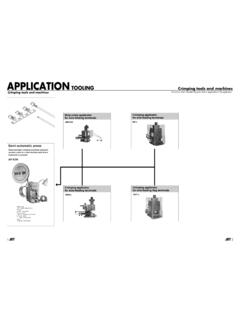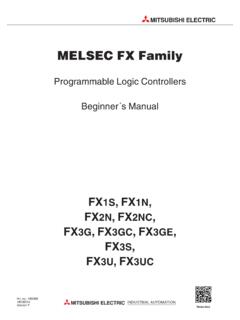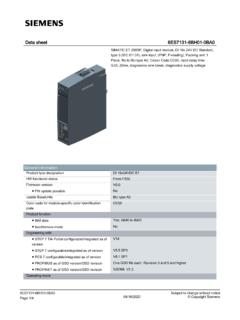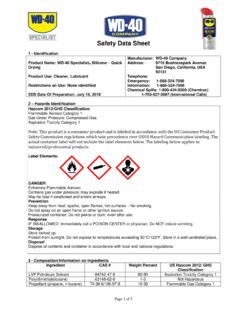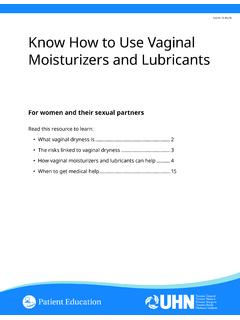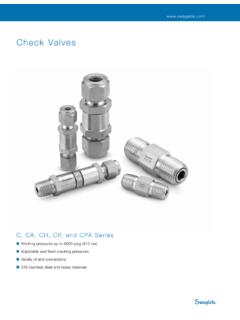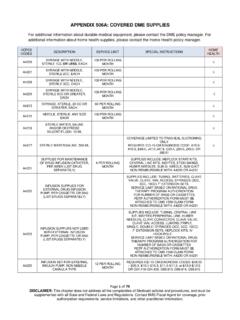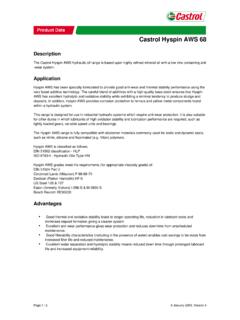Transcription of SAFETY DATA SHEET Silicone Oil
1 Revision date: 22/11/2019 Revision: SAFETY DATA SHEET . Silicone Oil According to Regulation (EC) No 1907/2006, Annex II, as amended. Commission Regulation (EU) No 2015/830. of 28 May 2015. SECTION 1: Identification of the substance/mixture and of the company/undertaking Product identifier Product name Silicone Oil Product number OSL, EOSL400, ZE. Relevant identified uses of the substance or mixture and uses advised against Identified uses Lubricant. Uses advised against No specific uses advised against are identified. Details of the supplier of the SAFETY data SHEET Supplier ELECTROLUBE. A division of HK WENTWORTH LTD. ASHBY PARK, COALFIELD WAY, ASHBY DE LA ZOUCH, LEICESTERSHIRE LE65 1JR. UNITED KINGDOM. +44 (0)1530 419600. +44 (0)1530 416640. Emergency telephone number Emergency telephone IN CASE OF EMERGENCY CALL: +44 1865 407333 (24hr, Provided by Carechem 24).
2 +353 (0)1 809 2166 (Beaumont Hospital, Republic of Ireland only, 8am-10pm, 7 days a week). SECTION 2: Hazards identification Classification of the substance or mixture Classification (EC 1272/2008). Physical hazards Aerosol 1 - H222, H229. Health hazards STOT SE 3 - H336 Asp. Tox. 1 - H304. Environmental hazards Aquatic Chronic 2 - H411. Label elements Hazard pictograms Signal word Danger Hazard statements H222 Extremely flammable aerosol. H229 Pressurised container: may burst if heated. H336 May cause drowsiness or dizziness. H411 Toxic to aquatic life with long lasting effects. 1/12. Revision date: 22/11/2019 Revision: Silicone Oil Precautionary statements P210 Keep away from heat, hot surfaces, sparks, open flames and other ignition sources. No smoking. P211 Do not spray on an open flame or other ignition source.
3 P251 Do not pierce or burn, even after use. P261 Avoid breathing spray. P410+P412 Protect from sunlight. Do not expose to temperatures exceeding 50 C/122 F. P501 Dispose of contents/ container in accordance with national regulations. Contains pentane Supplementary precautionary P271 Use only outdoors or in a well-ventilated area. statements P273 Avoid release to the environment. P304+P340 IF INHALED: Remove person to fresh air and keep comfortable for breathing. P312 Call a POISON CENTRE/doctor if you feel unwell. P391 Collect spillage. P403+P233 Store in a well-ventilated place. Keep container tightly closed. Other hazards This product does not contain any substances classified as PBT or vPvB. SECTION 3: Composition/information on ingredients Mixtures pentane 60-100%.
4 CAS number: 109-66-0 EC number: 203-692-4 REACH registration number: 01- 2119459286-30-XXXX. Classification Flam. Liq. 2 - H225. STOT SE 3 - H336. Asp. Tox. 1 - H304. Aquatic Chronic 2 - H411. Carbon Dioxide 1-5%. CAS number: 124-38-9. Classification Press. Gas (Comp.) - H280. The full text for all hazard statements is displayed in Section 16. SECTION 4: First aid measures Description of first aid measures General information Get medical attention immediately. Show this SAFETY Data SHEET to the medical personnel. Inhalation Remove affected person from source of contamination. Move affected person to fresh air and keep warm and at rest in a position comfortable for breathing. Maintain an open airway. Loosen tight clothing such as collar, tie or belt. When breathing is difficult, properly trained personnel may assist affected person by administering oxygen.
5 Place unconscious person on their side in the recovery position and ensure breathing can take place. 2/12. Revision date: 22/11/2019 Revision: Silicone Oil Ingestion Rinse mouth thoroughly with water. Remove any dentures. Give a few small glasses of water or milk to drink. Stop if the affected person feels sick as vomiting may be dangerous. Do not induce vomiting unless under the direction of medical personnel. If vomiting occurs, the head should be kept low so that vomit does not enter the lungs. Never give anything by mouth to an unconscious person. Move affected person to fresh air and keep warm and at rest in a position comfortable for breathing. Place unconscious person on their side in the recovery position and ensure breathing can take place. Maintain an open airway.
6 Loosen tight clothing such as collar, tie or belt. Skin contact Rinse with water. Eye contact Rinse immediately with plenty of water. Remove any contact lenses and open eyelids wide apart. Continue to rinse for at least 10 minutes. Protection of first aiders First aid personnel should wear appropriate protective equipment during any rescue. Wash contaminated clothing thoroughly with water before removing it from the affected person, or wear gloves. It may be dangerous for first aid personnel to carry out mouth-to-mouth resuscitation. Most important symptoms and effects, both acute and delayed General information See Section 11 for additional information on health hazards. The severity of the symptoms described will vary dependent on the concentration and the length of exposure.
7 Inhalation A single exposure may cause the following adverse effects: Headache. Nausea, vomiting. Central nervous system depression. Drowsiness, dizziness, disorientation, vertigo. Narcotic effect. Ingestion Due to the physical nature of this product, it is unlikely that ingestion will occur. Aspiration hazard if swallowed. Entry into the lungs following ingestion or vomiting may cause chemical pneumonitis. Skin contact Repeated exposure may cause skin dryness or cracking. Eye contact May be slightly irritating to eyes. May cause discomfort. Indication of any immediate medical attention and special treatment needed Notes for the doctor Treat symptomatically. SECTION 5: Firefighting measures Extinguishing media Suitable extinguishing media The product is flammable.
8 Extinguish with alcohol-resistant foam, carbon dioxide, dry powder or water fog. Use fire-extinguishing media suitable for the surrounding fire. Unsuitable extinguishing Do not use water jet as an extinguisher, as this will spread the fire. media Special hazards arising from the substance or mixture Specific hazards Containers can burst violently or explode when heated, due to excessive pressure build-up. Bursting aerosol containers may be propelled from a fire at high speed. If aerosol cans are ruptured, care should be taken due to the rapid escape of the pressurised contents and propellant. Vapours may form explosive mixtures with air. Hazardous combustion Thermal decomposition or combustion products may include the following substances: products Harmful gases or vapours.
9 Advice for firefighters 3/12. Revision date: 22/11/2019 Revision: Silicone Oil Protective actions during Avoid breathing fire gases or vapours. Evacuate area. Keep upwind to avoid inhalation of firefighting gases, vapours, fumes and smoke. Ventilate closed spaces before entering them. Cool containers exposed to heat with water spray and remove them from the fire area if it can be done without risk. Cool containers exposed to flames with water until well after the fire is out. If a leak or spill has not ignited, use water spray to disperse vapours and protect men stopping the leak. Avoid discharge to the aquatic environment. Control run-off water by containing and keeping it out of sewers and watercourses. If risk of water pollution occurs, notify appropriate authorities.
10 Special protective equipment Wear positive-pressure self-contained breathing apparatus (SCBA) and appropriate protective for firefighters clothing. Firefighter's clothing conforming to European standard EN469 (including helmets, protective boots and gloves) will provide a basic level of protection for chemical incidents. SECTION 6: Accidental release measures Personal precautions, protective equipment and emergency procedures Personal precautions No action shall be taken without appropriate training or involving any personal risk. Keep unnecessary and unprotected personnel away from the spillage. Wear protective clothing as described in Section 8 of this SAFETY data SHEET . Follow precautions for safe handling described in this SAFETY data SHEET . Wash thoroughly after dealing with a spillage.




